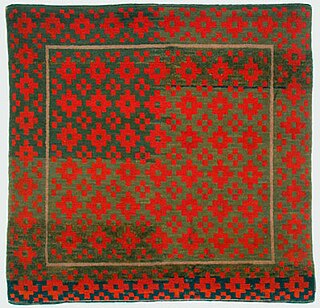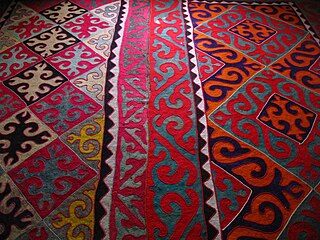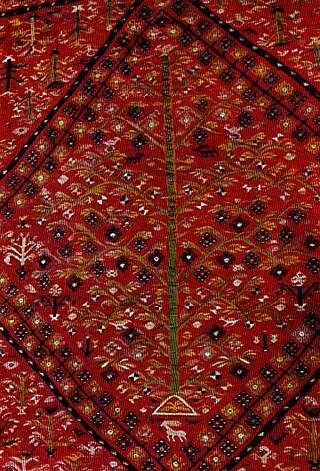Related Research Articles

A rug is a piece of cloth, similar to a carpet, but it does not span the width of a room and is not attached to the floor. It is generally used as a floor covering, or as a decorative feature.

A carpet is a textile floor covering typically consisting of an upper layer of pile attached to a backing. The pile was traditionally made from wool, but since the 20th century synthetic fibers such as polypropylene, nylon, or polyester have often been used, as these fibers are less expensive than wool. The pile usually consists of twisted tufts that are typically heat-treated to maintain their structure. The term carpet is often used in a similar context to the term rug, but rugs are typically considered to be smaller than a room and not attached to the floor.

Tibetan rug making is an ancient, traditional craft. Tibetan rugs are traditionally made from Tibetan highland sheep's wool, called changpel. Tibetans use rugs for many purposes ranging from flooring to wall hanging to horse saddles, though the most common use is as a seating carpet. A typical sleeping carpet measuring around 3 ft × 5 ft is called a khaden.

A Persian carpet, Persian rug, or Iranian carpet is a heavy textile made for a wide variety of utilitarian and symbolic purposes and produced in Iran, for home use, local sale, and export. Carpet weaving is an essential part of Persian culture and Iranian art. Within the group of Oriental rugs produced by the countries of the "rug belt", the Persian carpet stands out by the variety and elaborateness of its manifold designs.

The Turkmen people have traditionally been nomads and equestrians, and even today after the fall of the USSR attempts to urbanize the Turkmens have not been very successful. They never really formed a coherent nation or ethnic group until they were forged into one by Joseph Stalin in the 1930s. Rather they are divided into clans, and each clan has its own dialect and style of dress. Turkmens are famous for making knotted Turkmen carpets, often mistakenly called "Bukhara rugs" in the West. These are elaborate and colorful hand-knotted carpets, and these too help indicate the distinctions among the various Turkmen clans.

Uşak carpets, Ushak carpets or Oushak Carpets are Turkish carpets that use a particular family of designs, called by convention after the city of Uşak, Turkey – one of the larger towns in Western Anatolia, which was a major center of rug production from the early days of the Ottoman Empire, into the early 20th century.
An oriental rug is a heavy textile made for a wide variety of utilitarian and symbolic purposes and produced in "Oriental countries" for home use, local sale, and export.

The Karabakh carpet, or Artsakh carpet, is one of the varieties of carpets of Transcaucasia, made in the Karabakh region.

Azerbaijani carpet is a traditional carpet (rug) made in Azerbaijan. The Azerbaijani carpet is a handmade textile of various sizes, with a dense texture and a pile or pile-less surface, whose patterns are characteristic of Azerbaijan's many carpet-making regions. Traditionally, the carpets were used in Azerbaijan to cover floors, decorate interior walls, sofas, chairs, beds and tables.

A Turkmen rug is a type of handmade floor-covering textile traditionally originating in Central Asia. It is useful to distinguish between the original Turkmen tribal rugs and the rugs produced in large numbers for export mainly in Pakistan and Iran today. The original Turkmen rugs were produced by the Turkmen tribes who are the main ethnic group in Turkmenistan and are also found in Afghanistan and Iran. They are used for various purposes, including tent rugs, door hangings and bags of various sizes.

The State Museum of Turkmenistan, also known as the Saparmurat Turkmenbashi Museum, is a museum in Ashgabat, Turkmenistan. The museum was opened on 12 November 1998. The museum has seven permanent galleries incorporating history, present day culture, and ethnography.
An Afghan rug is a type of handwoven floor-covering textile traditionally made in the northern and western areas of Afghanistan, mainly by Afghan Turkmens and Uzbeks. The industry is being expanded to all 34 provinces of Afghanistan.

A shyrdak or syrmak is a stitched, and often colourful felt floor and wallcovering, usually handmade in Central Asia. Kazakhs and Kyrgyz people alike traditionally make shyrdaks, and most especially in Kyrgyzstan the tradition is kept alive, with products also sold to tourists.

Ala kiyiz or tekemet is an ornamenting style for textile floor- or wallcovering made by pressing wet, soaped wool of various colours together to make it felt. The chemical process of felting transforms the loose woolen fibers into a thick cloth. The felt carpet-making technique is a traditional folk art among the nomadic farming Kazakh, Kyrgyz and Mongolian peoples of the Tien Shan mountains and the steppes in Central Asia for over two and a half thousand years. From the various methods of ornamenting, ala kiyiz is among the widest spread, with shyrdak.

Caucasian carpets and rugs are primarily made in villages, rather than in cities. They are made from materials particular to individual tribal provinces, the rugs of the Caucasus normally display bold geometric designs in primary colors. Styles typical to the Caucasus region are Daghestan, Verne, Shirvan, Ganja, Kazakh, Karabagh, and Quba rugs. Several carpet styles from contemporary northwestern Iran also fall largely into this bracket, such as the Ardabil rugs.

Chiprovtsi kilims are handmade flatwoven kilim rugs with two identical sides, part of Bulgarian national heritage, traditions, arts and crafts and pertain to the Western Bulgarian kilim weaving tradition. Their name is derived from the town of Chiprovtsi where their production started in the 17th century.

Ganja rugs or Geunge rugs are a category of Caucasian rugs from the town of Gəncə in Azerbaijan.

A pictorial carpet, picture carpet, tableau rug, carpet tableau or rug tableau is an ornamental rug specially prepared for hanging on room and hall walls for decoration. The designs and samples on pictorial carpets are completely different from those on common floor rugs. Pictorial carpets are generally made of silk but they have also been made from wool. Pictorial carpets are usually framed to sell and use.

Uzbek carpet is one of the best-known handmade carpets produced by Uzbeks. Carpet weaving, being one of the types of Uzbek arts and crafts, is inextricably linked with other kinds of Uzbek arts and crafts, continuing the tradition of other types of national fine art. Originally carpet in Uzbekistan is flourishing in such villages as Qamashi, Mirichkar and Dzheynau in Qashqadaryo Region.
References
- ↑ Chahryar, Adle; M, Baipakov, Karl; Irfan, Habib; UNESCO (2003-12-31). History of civilizations of Central Asia: Development in contrast: from the sixteenth to the mid-nineteenth century. UNESCO Publishing. ISBN 978-92-3-103876-1.
{{cite book}}: CS1 maint: multiple names: authors list (link) - ↑ HALI: The International Journal of Oriental Carpets and Textiles. Oguz Press. 2005.